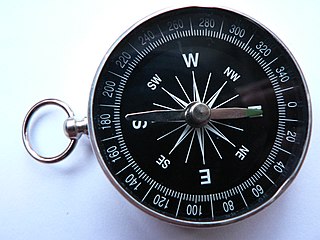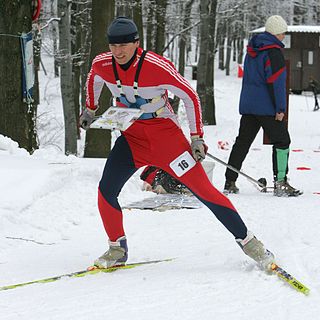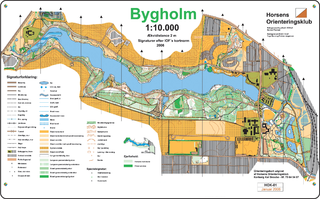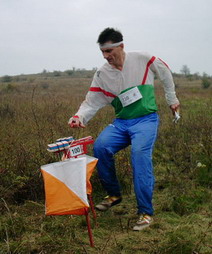
Orienteering is a group of sports that require navigational skills using a map and compass to navigate from point to point in diverse and usually unfamiliar terrain whilst moving at speed. Participants are given a topographical map, usually a specially prepared orienteering map, which they use to find control points. Originally a training exercise in land navigation for military officers, orienteering has developed many variations. Among these, the oldest and the most popular is foot orienteering. For the purposes of this article, foot orienteering serves as a point of departure for discussion of all other variations, but almost any sport that involves racing against a clock and requires navigation with a map is a type of orienteering.

A compass is a device that shows the cardinal directions used for navigation and geographic orientation. It commonly consists of a magnetized needle or other element, such as a compass card or compass rose, which can pivot to align itself with magnetic north. Other methods may be used, including gyroscopes, magnetometers, and GPS receivers.

TREC, short for the French Techniques de Randonnée Équestre de Compétition is an equestrian discipline designed to test horse and rider. With origins in France, the sport has spread through Europe, and was introduced to the UK by the British Horse Society (BHS) in 1998. The sport is now known as British TREC and is run by TREC GB. TREC competitions consist of three separate events (phases) - mounted orienteering, a demonstration of control of the horse's paces and an obstacle course - all completed over the course of one or two days, and points scored, with the highest scoring being declared the overall event winner.

Mountain bike racing is the competitive cycle sport discipline of mountain biking held on off-road terrain. The Union Cycliste Internationale (UCI) recognised the discipline relatively late in 1990, when it sanctioned the world championships in Durango, Colorado. The first UCI Mountain Bike World Cup series took place in 1988. Its nine-race circuit covered two continents—Europe and North America—and was sponsored by Grundig. Cross-country racing was the only World Cup sport at this time. In 1993, a six-event downhill World Cup was introduced. In 1996, cross-country mountain biking events were added to the Olympic Games. In 2006, cross-country mountain biking events became part of the World Deaf Cycling Championships for the first time in San Francisco, USA.

Amateur radio direction finding is an amateur racing sport that combines radio direction finding with the map and compass skills of orienteering. It is a timed race in which individual competitors use a topographic map, a magnetic compass and radio direction finding apparatus to navigate through diverse wooded terrain while searching for radio transmitters. The rules of the sport and international competitions are organized by the International Amateur Radio Union. The sport has been most popular in Eastern Europe, Russia, and China, where it was often used in the physical education programs in schools.
Radio Orienteering in a Compact Area is a variation of Amateur Radio Direction Finding. ROCA is a timed race in which individual competitors use a topographic map and a magnetic compass to navigate through diverse, wooded terrain while searching for radio transmitters.
The term control card can refer to:
Mounted orienteering is the practice of orienteering while riding a horse or other riding animal.

Ski orienteering (SkiO) is a cross-country skiing endurance winter racing sport and one of the four orienteering disciplines recognized by the IOF. A successful ski orienteer combines high physical endurance, strength and excellent technical skiing skills with the ability to navigate and make the best route choices while skiing at a high speed.

An orienteering map is a map specially prepared for use in orienteering competitions. It is a topographic map with extra details to help the competitor navigate through the competition area.

Trail orienteering (TrailO) is an orienteering sport that involves precise reading of an orienteering map and the corresponding terrain. Trail orienteers must identify, in the terrain and in the presence of decoys, control points shown on the map. TrailO involves navigation skills but unlike most other forms of orienteering, it involves no point to point racing and little or no route choice. It is conducted usually on trails and because the objective is accuracy, not the speed of physical movement, the sport is accessible to physically disabled competitors on equal terms as able-bodied.
The Orienteering World Cup is a series of orienteering competitions organized annually by the International Orienteering Federation. Two unofficial cups were organized in 1983 and 1984. The first official World Cup was held in 1986, and then every second year up to 2004. From 2004 the World Cup has been held annually.

Martin Johansson is a Swedish orienteering, ski-orienteering, and cross-country skiing competitor, a medallist at the orienteering world championships, and a 2004 Junior World Champion in relay. He received bronze medals in sprint at the World Orienteering Championships in Kyiv in 2007 and in Olomouc in 2008. His brother, Lars, is a member of the Rockford Icehogs
The history of orienteering begins in the late 19th century in Sweden, where it originated as military training. The actual term "orienteering" was first used in 1886 at the Swedish Military Academy Karlberg and meant the crossing of unknown land with the aid of a map and a compass. The competitive sport began when the first competition was held for Swedish military officers on 28 May 1893 at the yearly games of the Stockholm garrison. The first civilian competition, in Norway on 31 October 1897, was sponsored by the Tjalve Sports Club and held near Oslo. The course was long by modern standards, at 19.5 km, on which only three controls were placed. The competition was won by Peder Fossum in a time of 1 hour, 47 minutes, and 7 seconds.

Mountain bike orienteering is an orienteering endurance racing sport on a mountain bike where navigation is done along trails and tracks. Compared with foot orienteering, competitors usually are not permitted to leave the trail and track network. Navigation tactics are similar to ski-orienteering, where the major focus is route choice while navigating. The main difference compared to ski-orienteering is that navigation is done at a higher pace, because the bike can reach higher speeds. As the biker reaches higher speeds, map reading becomes more challenging.
An orienteering course is composed of a start point, a series of control points, and a finish point. Controls are marked with a white and orange flag in the terrain, and corresponding purple symbols on an orienteering map. The challenge is to complete the course by visiting all control points in the shortest possible time, aided only by the map and a compass.
Canoe orienteering (canoe-O) is an orienteering sport using a canoe, kayak, or other small boat. Usually, a canoe-O is a timed race in which one- or two-person boats start at staggered intervals, are timed, and are expected to perform all navigation on their own. Portages are allowed. The control points, shown on an orienteering map, may be visited in any order. Standings are determined first by successful completion of the course, then by shortest time on course.

Foot orienteering is the oldest formal orienteering sport, and the one with the most "starts" per year. Usually, a FootO is a timed race in which participants start at staggered intervals, are individually timed, and are expected to perform all navigation on their own. The control points are shown on the orienteering map and must be visited in the specified order. Standings are determined first by successful completion of the course, then by shortest time on course.

Underwater orienteering is an underwater sport that uses recreational open circuit scuba diving equipment and consists of a set of individual and team events conducted in both sheltered and open water testing the competitors' competency in underwater navigation. The competition is principally concerned with the effectiveness of navigation technique used by competitors to swim an underwater course following a route marked on a map prepared by the competition organisers, a compass and a counter meter to measure the distance covered. The sport was developed in the Soviet Union during the late 1950s and is played mainly in Europe. It is known as Orientation Sub in French and as La Orientación Subacuática in Spanish. Historically, the sport has also been known as Technical Disciplines.

Biathlon orienteering or orienteering shooting is a multisport consisting of shooting and orienteering. The sport is organized internationally by the International Biathlon Orienteering Federation (IBOF), and is mainly practiced in the Nordic countries as well as a few other European countries. Competitions are organised in Denmark by Danish Military Sports Association (DMSA), in Sweden by the civilian Swedish Multisport Association and in Finland by the Finnish Reservist Sports Federation (FRSF).























